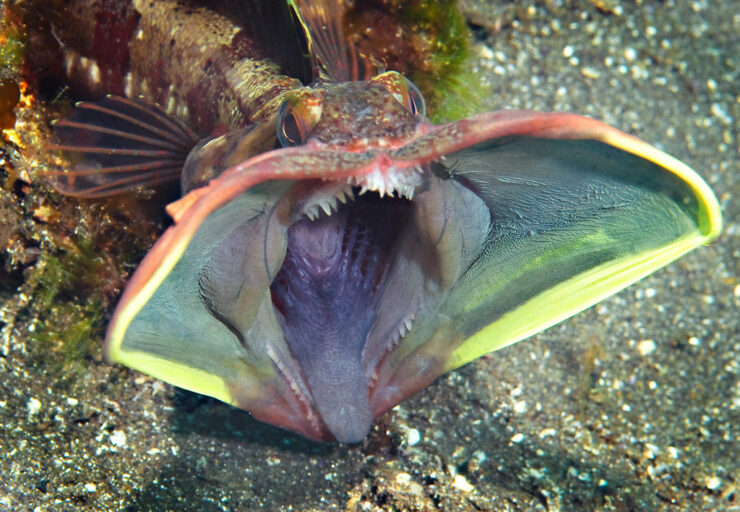Here is a video of a Sarcastic Fringehead, whose scientific name is “Neoclinus blanchardi”! This is a big one. If you were to see one underwater while scuba diving they look like a Big Ole Blenny.
The fish hanging there has kind of made it look more evil than when seen alive. The bottom jaw is more distended and pointed than you would see if it was underwater and not hanging.
Physical Characteristics
These resilient little fish pack a mighty punch despite their pocket-sized stature. Growing to a maximum of 12 inches, they are dwarfed by many sea creatures but make up for it with spunk and spirit. Their forms are long and slender, usually shaded in earthy hues of brown or grey with splashes of red or green at times. But it’s their oversized maws that truly command attention – so wide, the gaping jaws can flare to an impressive four times their usual size! Within those jaws lurk beams of vibrant color, crafted to startle any intruders.
Above their eyes float wispy fringe-like appendages that lend these pugnacious piscines their name. Called cirri, the thin protrusions wave softly, adding an ethereal flair to their already peculiar profiles. Powerful chest fins and petite pelvic fins propel them with agility. From the nape of their necks, a dorsal fin flows seamlessly to the tapered tail end.
Males typically have larger jaws than females. Their needle-like teeth are well-suited for their aggressive and highly territorial behavior.
Habitat and Distribution
The sarcastic fringehead occupies the coastal waters of the northeastern Pacific Ocean, ranging from San Francisco, California in the south to central Baja California, Mexico in the north. They are most commonly found at depths between 10-240 feet, allowing them to inhabit an assortment of benthic environments including sandy and muddy substrata, rocky reefs, and anthropogenic structures.
Shelter selection plays an important role in the ecology of the sarcastic fringehead. They frequently utilize empty gastropod shells, abandoned burrows, and crevices/overhangs in rocky outcroppings for refuge. In more polluted areas, discarded human debris such as bottles and cans may also be appropriated.
Territorial behavior is strongly exhibited as they vigorously defend chosen dwelling sites from conspecifics and other intruders.
Behavior and Diet
If another fringehead comes into its home area, it will open its big mouth really wide to try to scare the intruder away. They will also push their mouths against each other, like they are kissing. But they are really trying to push the other fish back to see who is stronger.
The sarcastic fringehead eats lots of different things. It likes small animals like other fish and shrimp. It also eats bug-like underwater creatures. When squid have their babies, these fish will eat a lot of the squid eggs. They are quick to catch food with fast mouth movements.
During the breeding season, the males want the females’ attention. To look impressive, the males show off their bright mouth colors and act aggressively. If a female likes one male, she will lay her eggs in his home area. Then he protects the eggs until they hatch. The males work hard to take care of the babies, showing these fish have complex social behaviors.
Interesting Facts
The term “sarcastic” is derived from the Greek word “sarkazein,” which means “to tear flesh.” This name likely refers to the fringehead’s extremely aggressive behavior and sharp teeth, which it uses to fiercely defend its territory against predators and rivals.
When these little fish feel threatened, they will open their gigantic mouths to unveil their razor-sharp teeth – a clear warning to any nearby fish or diver not to encroach. Some have even been known to take nips out of divers! So the name is pointing to their bold and flesh-tearing tendencies when protecting their homes, not implying they act in a sarcastic manner.
Scientists have learned interesting facts about how these fish live and act through careful observation.
In areas polluted by trash, researchers discovered fringeheads using man-made items like bottles as shelters. While not their natural habitat, this shows their ability to adapt. However, it also means pollution takes away the reefs and holes they normally live in.
Last Words
Its uniquely patterned mouth and fiercely territorial behavior make it stand out among reef dwellers. By adapting to use both natural shelters and human debris, this resilient fish demonstrates ecological flexibility. As an opportunistic predator consuming small fish and invertebrates such as squid eggs, it plays an important role in local undersea communities.

